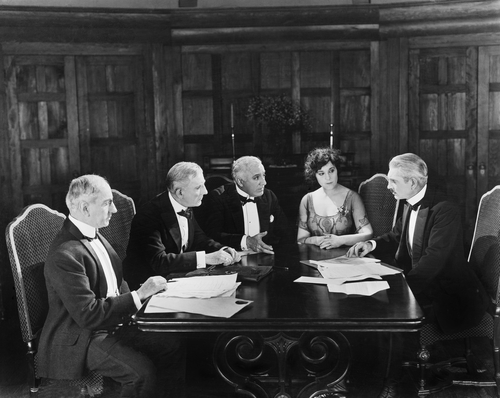5 tips to chair a board meeting outstandingly
29 May 2015 By Northern Lights

One of the issues often raised by leaders is how to chair a board or meeting successfully. Here I share my tips from chairing boards myself and from having been on the receiving end of not great chairmanship!
In our research for helping women to be recognised and promoted, a particular issue that they mention is how they should chair meetings (read our report on what women say they want help with). Some of this is about positioning themselves and being seen as a leader – but it is just as much of an issue for men. I regret to say I have sat through too many dreadfully chaired meetings; since they have mostly been male chairs, they need the help even if they don’t recognise it!!
My own view is that if you get the business side of a board meeting done really well – that will do huge amounts for your personal brand. You will be seen as a leader.
Our colleague Vania Henry has just been appointed chair of the board of the Benelux Business Council of Abu Dhabi. She asked for a few tips and I thought some of these might be useful for others. Many of the principles I shared in this blog on moderating and facilitating events also apply to chairing a board.
1. Preparation is the key
I have come to the conclusion that preparation is probably 40% of a successful board meeting. And the most important part is to decide ‘what do we want to achieve from this meeting?’.
Of course there are the basics of governance to be covered off, but most people join a board to make a contribution – especially if they are doing it voluntarily. I’ve sat on boards where people have flown in from China and San Francisco and wondered at the end of the meeting – why?! What value did they really feel their time had made.
When I am planning a board meeting, I mentally add up the time and consultancy value of board members’ time (including travel time) and think – how do we make £20k or £50k of time really deliver back that value?
One of the problems is that most executives are rushing around ‘doing’ and ‘fixing’ and a board meeting is often just something in the monthly calendar that has to be got through. So getting a ceo or dean to stop and think ‘what would success look like?’ is hard. And that is up to the chair to plan ahead and make it easy for the ceo to do that.
Once you know what the meeting should achieve
- What information does each board member need in advance and at the meeting, in order to contribute the most from their time?
- Send out succinct papers/information in advance so that board members can think or research in advance – often they may want to ask colleague views if something is not particularly their area of expertise
- If additional information should be given at the meeting in the form of presentations, then manage this tightly. Brief the person giving the presentation as to why and what they need to say. Don’t let them repeat what has been sent out already, but add to it with stories or Q&A. Tell them they have 10 minutes or whatever and that is it – you will cut them off at that point
Do an agenda where there is proper time allocated to the key issues and find ways to manage the necessary house-keeping without letting those dominate the time.
 2. Preparing board papers
2. Preparing board papers
Oh my goodness, board papers! I must have had every combination over the years. Long reports from individual departments (which are then read out at the meeting); finances presented so you can’t work out the key issues – a particular issue with universities and charities; long-winded (moaning) reports from directors about why nothing is the way expected; strategy papers that haven’t got a strategy in them; the briefest agenda so you have no idea what will be covered.
There are two sorts of papers for a board meeting
- Board members need to know: are we solvent; where are the risks and how have they been addressed; what’s coming up that could be a problem and what is being done
- Adding value. This is where you want the combined expertise of your board to help you with strategy, their experience, contacts, views on how something would work
With both of these, put your head into the board members’ heads. What information do I need to check everything is OK, what do I need in advance so I can really add value at the meeting?
The golden rule: succinct is nearly always best.
3. Think mobile
When you are sending out documents, think about where and how they will be read – on a smartphone, an ipad, a laptop without wifi, a desktop. I was once sent a set of board papers with 10 links to the key information – I couldn’t get wifi at the time so I left it to read another time (and of course forgot till the last minute). The papers made no sense if you couldn’t get the links – key points should have been put into the main document. Another board used to send out about a dozen papers all as separate attachments – you got lost with what you had opened and read or not.
The best board papers I have seen are where the reports and accounts are in neat summary documents into one pdf so you can open it and read the whole lot in one go.
Mobile communications are a particular challenge these days – not just for board papers. You need to think about key messages or points in the paper – are they clearly highlighted in an email so even if someone is skimming on their mobile, they can see what is needed?
4. Chairing the meeting
I think the three key ingredients to successful chairing are: managing time – enough for discussion and contribution; but not to lose the plot; ensuring everyone contributes and that the loudmouths are managed; you reach a conclusion that achieves the purpose of the meeting.
I break the meeting down into time chunks for my personal notes and this helps me watch deadlines of discussions for each part of the meeting. I also jot down the key decision that is needed for each part of the meeting.
I make sure everyone knows we will keep to time and try and keep the meeting moving – as kindly as I can. Again, this needs considerable preparation and planning to achieve that.
 And above all, finish on time. I have watched the faces of board members when we have gone 15 minutes over time and no end is in sight. Everyone has packed up in their minds mentally – checking phones and messages, rushing off to another meeting. Once you have hit the specified time to finish, the value of contributions after this is very rarely worth much. People have left the meeting in their minds if not from their seats.
And above all, finish on time. I have watched the faces of board members when we have gone 15 minutes over time and no end is in sight. Everyone has packed up in their minds mentally – checking phones and messages, rushing off to another meeting. Once you have hit the specified time to finish, the value of contributions after this is very rarely worth much. People have left the meeting in their minds if not from their seats.
Finishing on time is always appreciated by board members!
5. Be accessible to board members
Many people seem to start chairing boards as they are leaving commercial life and building a new portfolio. Suddenly they don’t have proper secretarial support and don’t seem able to respond at the pace most business people expect these days. I have now had five chairs of various boards who almost never reply to emails. Other board members have asked me ‘is it me?’ because they thought the chair was just ignoring them.
If you are taking on a chairman – or board role – these days, your colleagues will expect a reply to emails within the week. Within a day is good. Even if you are doing this voluntarily, are on holiday or can’t get back with a full answer, at least do a quick response. It is incredibly demotivating for silence to greet every email or call.
So those are my tips. I found lots of other great websites with the more traditional aspects of chairing a meeting (see below) but I wanted to cover the communications side of board meetings here.
How to chair a board of directors meeting
Chairing a board meeting
What is your worst board chairman experience? What would you say is the most important point for a chair to learn?



